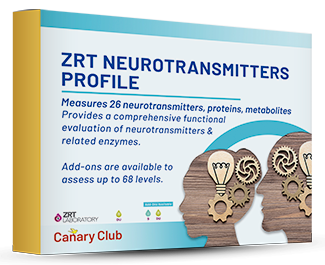Serotonin: Estrogen’s Dance Partner...
It is common practice to look at hormone imbalance when addressing symptoms of premenstrual syndrome (PMS) - in particular, estrogen dominance. However, PMS may also be the result of a broader neuroendocrine dysfunction. A great complement to hormone balancing is also addressing neurotransmitter imbalance.
 The dance between ovarian hormones and brain chemistry will ultimately determine a woman's experience of her menstrual cycle. The availability of serotonin can affect the degree of resulting mood fluctuations.
The dance between ovarian hormones and brain chemistry will ultimately determine a woman's experience of her menstrual cycle. The availability of serotonin can affect the degree of resulting mood fluctuations.
In the second half of the cycle, after ovulation, estrogen naturally drops. If you are a woman who is prone to low levels of serotonin, the estrogen drop that occurs premenstrually may be all it takes to lower your serotonin level below the point of optimum functioning. This results in a "negative" mood that mysteriously vanishes as soon as your period starts and estrogen levels rise again.
Why does this happen?
Additional Neuro-Endocrine Factors
Progesterone also plays a key role in the monthly cycle, and like estrogen, it affects neurotransmitters. Progesterone is a GABA agonist.2,3 Well-balanced GABA is important for stress management and in maintaining a balanced mood. The rise and fall of progesterone in the luteal phase (second half) of the menstrual cycle will influence GABA levels4, although not quite to the extent of estrogen’s influence on serotonin.
 Speaking of stress, the "stress hormone" cortisol, produced by the adrenal glands, has an effect on female hormones and neurotransmitters. Long-term elevated cortisol production in turn lowers estrogen as well as serotonin production. Therefore it is important to reduce stress-provoking elements in your life during the second half of your menstrual cycle, especially if you are prone to PMS. Scheduling a spa day? Make it during your luteal phase!
Speaking of stress, the "stress hormone" cortisol, produced by the adrenal glands, has an effect on female hormones and neurotransmitters. Long-term elevated cortisol production in turn lowers estrogen as well as serotonin production. Therefore it is important to reduce stress-provoking elements in your life during the second half of your menstrual cycle, especially if you are prone to PMS. Scheduling a spa day? Make it during your luteal phase!
Norepinephrine is an excitatory neurotransmitter that plays a significant role in managing anxiety, irritability, and emotional balance. Reduction in serotonin levels commonly associated with stress and declining adrenal function can cause a rise in norepinephrine, which contributes to increased anxiety and irritability.
Addressing neurotransmitter imbalance is an important complement to hormone therapies for managing menstrual cycle symptoms. Simple non-invasive urine testing helps to identify your specific, unique imbalances. With female hormone testing, you collect your samples about 3 weeks into your cycle. This measures your levels during the luteal phase when estrogen and serotonin (and the person!) tend to be depressed.
ZRT Neurotransmitters Profile
 See our ZRT Neurotransmitters Profile to check your neurotransmitter levels. Samples are taken from dried urine, with the exception of the saliva steroids add-on option.
See our ZRT Neurotransmitters Profile to check your neurotransmitter levels. Samples are taken from dried urine, with the exception of the saliva steroids add-on option.
Neurotransmitters Test Kit Includes:
Neurotransmitters Dried Urine: GABA, Glu, Gly, DA, Epi, NE, HIST, 5-HT, PEA, DOPAC, HVA, 5-HIAA, NMN, VMA, Trp, Kyn, 3-OHKyn, Tau, Gln, His, N-MeHist, Tyra, KynAc, Xanth, Tyr, Crtn
Available Neurotransmitter Add-ons:
You will be able to include these add-ons during the ordering process for the Neurotransmitters Panel.
Neurotransmitters + Saliva Steroids Concerned about hormone imbalances? Use the tube in the Neurotransmitter kit to collect a Saliva sample for Estradiol, Progesterone, Testosterone, DHEA-S & AM Cortisol.
Neurotransmitters + Diurnal Cortisol (UDH) I Don't want to test Melatonin. Add only Free Cortisol & Free Cortisone x4 to the same samples being collected for Neurotransmitters.
Neurotransmitters + Diurnal Cortisol & Melatonin UDH II - For concerns about adrenal or sleep issues, add 4-point Cortisol, Cortisone & Melatonin to the same samples being collected for Neurotransmitters.
Neurotransmitters + Diurnal Cortisol, Melatonin, Norepinephrine & Epinephrine UDH III For concerns about adrenal or sleep, stress issues, add Free Cortisol x 4, Free Cortisone x 4, Melatonin (MT6s) x 4, NE x 4 & Epi x 4 to the same samples being collected for Neurotransmitters.
add 7 Toxic Heavy Metals Urine Elements – $99 – Add tests for Iodine, Bromine, Selenium, Lithium, Arsenic, Cadmium & Mercury
Additional Resources
- Neurotransmitter Fact Sheet
- Neuroendocrine Imbalances and Depression
- Our Emotions Reflect Our Neurotransmitter Hormone Balance
- Why You Might Be Starving Your Brain
- Dopamine and New Year's Resolutions
- Neurotransmitter Disruption and Adrenal Function
- Neurotransmitter Imbalances and Mood Disorders
- Forbes Article

